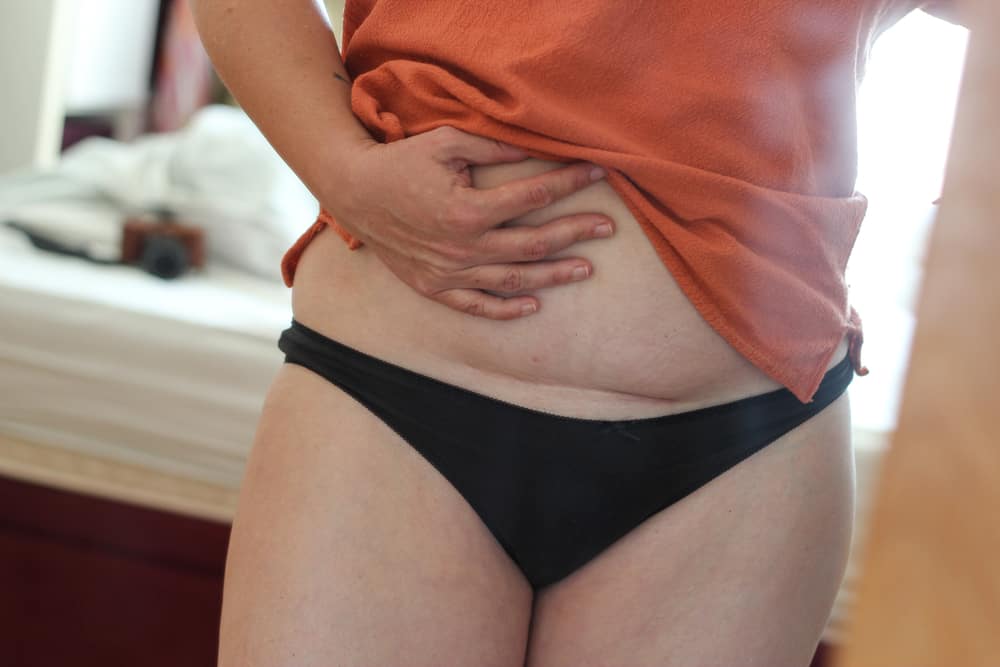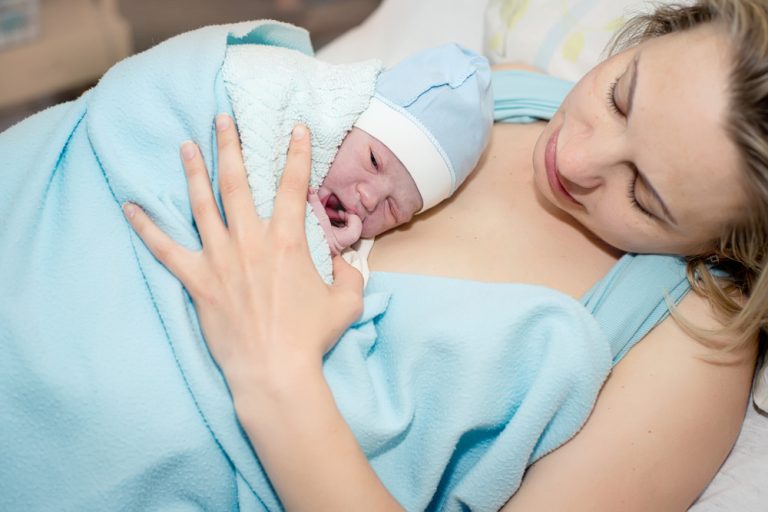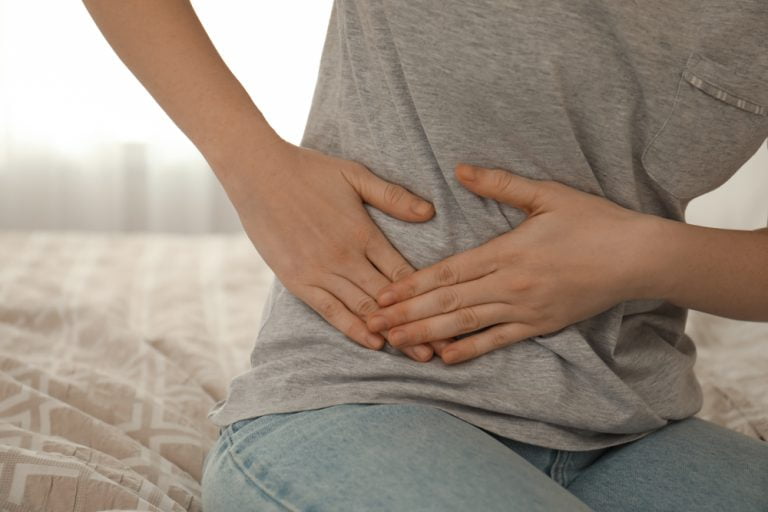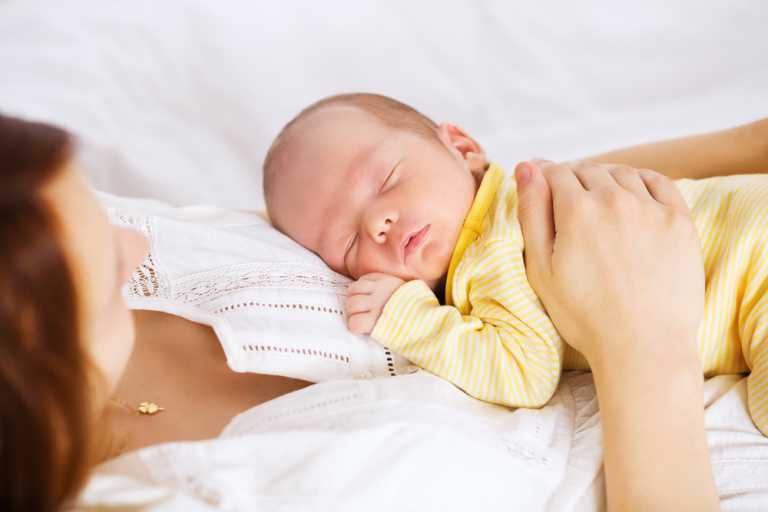After a c-section, your body will race to repair the damage to the seven layers of tissue in just six weeks. Unfortunately, the cells involved in the repair can’t tell one type of tissue from another, and if two touch during healing, it can result in adhesions.
For most, these produce no symptoms. But for some, they can cause pain by restricting tissue and organ movement, function, and blood flow.
Here’s everything you need to know about diagnosing, treating, and preventing adhesions from a c-section. As well as when to seek urgent medical help.
What Are Adhesions?
Adhesions are bands of scar tissue that join two, usually separate, parts of your body together. They can develop as a few thick fibrous bands or as a web of thin, nylon-strength collagen threads covering multiple organs and tissues.
The areas they can affect include:
- Skin
- Fascia
- Abdominal wall
- Intestines
- Uterus
- Ovaries
- Fallopian tubes
- Bladder
- Peritoneum
They can occur after internal inflammation, trauma, or injury and are very common after cesarean births.
What Are the Risk Factors for Developing Adhesions After a C-Section?
Research shows that you are more likely to have trouble with adhesions if:
- You’ve had a number of previous cesareans or abdominal incisions. For example, an operative hysteroscopy or a complicated dilation and curettage.
- You are overweight.
- You are an older mother.
- You’ve suffered a postpartum infection.
- You have endometriosis.
Symptoms of Adhesions
Your tissues and organs are slippery, so they can slide past one another as you move.
The most common problem with adhesions is that they prevent this movement, resulting in pulling, tugging, and extreme pain. Occasionally, they may even bind your organs or stick them to themselves. This can restrict blood supply and stop them from working.
These issues can cause symptoms like:
- Chronic pelvic pain.
- Severe abdominal pain.
- Discomfort during bowel movements.
- Back pain.
- Increased pain during menstruation.
- Chronic constipation.
- Complete or partial bowel obstruction.
- Vomiting.
- Inability to pass gas.
- Bloating.
- Infertility.
- Pain during intercourse.
- An indented scar.
- Depression.
While the problem tissue typically forms within just a few days of surgery, you may not experience symptoms for weeks, months, or even years. This can be confusing and make it difficult to diagnose the problem.
Diagnosing Adhesions
Unfortunately, no blood tests, x-rays, or scans can fully confirm the presence of adhesions. But your doctor will likely use these to rule out other causes for your symptoms.
Once they are reasonably sure that adhesions are to blame, you will undergo a diagnostic laparoscopy, which is keyhole surgery.
Treating Adhesions After a C-section
Frustratingly, despite adhesions being a huge problem for women after cesarean births, we still lack effective treatments. Currently, the only options are surgery, which carries the risk of further complications, or massage, which lacks supporting evidence.
Your doctor will advise you on the best procedure based on your medical history and the location and severity of your adhesions. Each comes with its own pros and cons:
Laparotomy
Your surgeon makes a large incision to fully open your abdominal cavity and remove the problem scar tissue.
This is an effective treatment for severe cases where your bowel has become completely blocked.
Pros
- This option gives your surgeon full access, allowing them to tackle the most extreme cases.
Cons
- Undergoing anesthesia comes with risks.
- There is a high chance that the open surgery will cause more adhesions to form. Many patients end up having more surgeries as the problems just keep coming back.
- You may have to stay in the hospital for a week.
- Recovery takes around 6 weeks.
Laparoscopy
A keyhole surgery is where your doctor inserts a camera and surgical tools through a small incision. Once they’ve identified the problems, they can cut them to release your tissue and organs.
Pros
- There’s a much lower chance of new adhesions forming.
- You can go home on the same day.
- Recovery takes around a week.
Cons
- Undergoing anesthesia comes with risks.
- Some cases are too severe to be treated this way.
Massage
In some cases, deep massage has been used to stretch and relieve pain from adhesions.
Pros
- There is no risk from undergoing anesthesia.
- There is no risk of new adhesions forming.
Cons
- It’s most successful if started soon after surgery.
- It’s not effective enough to treat the most severe cases.
- The supporting studies are very small and have been conducted by a group of physical therapists promoting their non-surgical adhesion release therapies.
- Doing it yourself at home after a small amount of training is possible.
How to Avoid Adhesions After a C-Section
With no perfect cure, your best option is to focus on prevention. Here are the most effective strategies:
Massage
While the data isn’t yet good enough to call massage a cure, it is an effective prevention method.
For it to work, you’ll need to start as soon as your scar is fully healed. For most, this will be around six weeks. You’ll also have to work much deeper into your abdomen than you think. So, doing some training or seeking treatment from a professional is essential.
Adhesion Barriers
These are physical barriers that a surgeon can place between your tissues and organs to stop them from sticking together. Then, once the risk of scar formation has passed, they dissolve. While not 100% effective, one study found they reduced the incidence of adhesions from 48% to 7.4%.
Surgical Technique
Your surgeon’s techniques and procedures during your cesarean play a large role in adhesion development. Where possible, you should ask your physician about the methods they use to prevent the condition and their rate of complications.
Even something as simple as whether they use starch-free, latex-free gloves can make a difference.
Avoid Postpartum Infection
Follow all the advice to minimize your risk of infection after birth. This includes:
- Keep your c-section scar clean and dry.
- Practice good hygiene when changing your dressing.
- Wait for the advised time before bending, lifting, driving, having sex, taking a bath, exercising, etc.
- Ensure you are given prophylactic antibiotics at the time of your surgery.
Medications
Various medications, including NSAIDs, can reduce the likelihood of developing problematic scar tissue. Speak to your doctor if you think you are at high risk, and they’ll prescribe the one most suited to you.
FAQs
How Common Are Adhesions After a C-Section?
The chance of developing adhesions is high, at 46-65% for first-time c-sections. Unfortunately, the risk increases with each subsequent delivery, reaching 75% for a third c-section and 83% for a fourth.
Are C-Section Adhesions Dangerous?
Most people will never experience symptoms from their adhesions. But, in extreme cases, they can become dangerous.
The most serious complication occurs when the bowel is affected, which can result in complete bowel obstruction.
This occurs when the adhesions close the bowel loops and cause a blockage. Partial blockages can be treated with diet, fluids, and laxatives. But complete blockages are a medical emergency due to the risk of rupture, which could cause the contents to flood your abdomen.
Seek immediate medical attention if you experience the following:
- Severe pain that doesn’t go away.
- An inability to poop or pass gas.
- A very bloated or distended abdomen.
- Nausea and vomiting.
- A fever.
The condition can also have consequences during future c-sections. The more scars you have, the more complicated the surgery will be. This results in higher rates of blood loss, an increase in delivery times, and a greater risk of bladder and bowel damage.
Can Adhesions Cause Infertility?
Yes, around 15 to 20% of pelvic adhesions result in infertility.
This can happen when scar tissue either blocks the fallopian tube or pulls the fallopian tube and ovary further apart. You may also experience infertility if scar tissue builds up inside your uterus. This is called Asherman Syndrome.
Fortunately, it’s usually possible to get pregnant again with surgery or IVF.




